An Integrated Approach for Electronic Waste Management—Overview of Sources of Generation, Toxicological Effects, Assessment, Governance, and Mitigation Approaches
Abstract
:1. Introduction
1.1. Review Research Methodology
1.2. Literature Review
2. Electronic Waste Toxicity
| No | Hazardous Elements | Detrimental Effects of the Hazardous Elements from E-Waste |
|---|---|---|
| 1 | Arsenic (As) | Impacts on the skin and slows down nerve conduction. Chronic contact with arsenic can occasionally be lethal and cause lung cancer [36]. |
| 2 | Lead (Pb) | Kidneys, reproductive systems, and neurological connections could all be affected. May lead to brain and blood issues and may be fatal [37]. |
| 3 | Barium (Ba) | Affects the cardiac muscle [38]. |
| 4 | Chromium (Cr) | Liver and kidney damage from chromium can lead to lung cancer and asthmatic bronchitis [39]. |
| 5 | Beryllium (Be) | May cause lung diseases [40]. |
| 6 | Mercury (Hg) | Growth of the foetus is hampered by its effects on the immune system, kidneys, and the brain. Injury to the liver or brain [41]. |
| 7 | Cadmium (Cd) | May lead to excruciating joint and back discomfort. It weakens bones and affects the kidneys [42]. |
| 8 | BFR (Brominated flame retardants) | Damage to the immunological and reproductive systems and possibly leading to hormonal imbalances such as thyroid disorders [43]. |
| 9 | Chlorofluorocarbon (CCl2F2) | Harm to the ozone layer. Both human skin cancer and organisms’ genetic harm could result from it [44]. |
| 10 | Polychlorinated Biphenyl (C12H10-nCln) | Animals’ immune systems, reproductive systems, neurological systems, and endocrine systems may be affected. May cause cancer. PCBs continuously poison the environment and harm it severely [45]. |
| 11 | Polyvinyl Chloride (C2H3Cl) | PVC burns with a hydrogen chloride gas that contains up to 56% chlorine and creates hydrochloric acid, which is harmful to the respiratory system [46,47]. |
| 12 | Dioxin | Extremely hazardous to mammals and can cause foetal abnormalities, slowed growth and reproduction, and immune system effects [48]. |
3. Health, Safety, and Environmental Impacts of E-Waste during Treatment Processes
Occupational Safety and Environmental Hazards Due to E-Waste
4. Current E-Waste Management in India
4.1. E-waste Management Approaches and Initiatives
4.2. E-Waste Management Agency
4.3. E-Waste Issues in the Electrical and Electronic Industry
4.4. Global Collection and Management Issues in Developing Countries
4.5. Benefits of E-Waste Management
5. Economic, Social, Environmental, and Human Health Implications of E-Waste in India
6. Recycling and Disposal Processes of E-Waste
6.1. Reuse and Recycling Techniques of E-Waste
6.2. Technological Methods for E-Waste Recycling
7. E-waste Management and SDGs
8. Concluding Remarks
Funding
Data Availability Statement
Conflicts of Interest
References
- Singh, R.; Kumar, R.; Singh, S. E-waste management: A review of trends, challenges and prospects for green economy. J. Clean. Prod. 2020, 268, 122018. [Google Scholar] [CrossRef]
- Ramprasad, C.; Gwenzi, W.; Chaukura, N.; Azelee, N.I.W.; Rajapaksha, A.U.; Naushad, M.; Rangabhashiyam, S. Strategies and options for the sustainable recovery of rare earth elements from electrical and electronic waste. Chem. Eng. J. 2022, 442 Pt 1, 135992. [Google Scholar] [CrossRef]
- United Nations University. Global E-Waste Monitor: 2014; United Nations University: Bonn, Germany, 2014. [Google Scholar]
- Awasthi, A.K.; Awasthi, M.K.; Mishra, S.; Sarsaiya, S.; Pandey, A.K. Evaluation of E-waste materials linked potential consequences to environment in India. Environ. Technol. Innov. 2022, 28, 102477. [Google Scholar] [CrossRef]
- Wang, Y.; Li, J.; He, W.; Chen, J.; Huang, J. E-waste recycling industry development and its barriers in China. Renew. Sustain. Energy Rev. 2019, 113, 109311. [Google Scholar] [CrossRef]
- Eurostat. Waste Statistics—Electrical and Electronic Equipment. 2020. Available online: https://ec.europa.eu/eurostat/statistics-explained/index.php/Waste_statistics_-_electrical_and_electronic_equipment (accessed on 30 October 2023).
- Wath, S.B.; Vaidya, A.N.; Dutt, P.S.; Chakrabarti, T. A roadmap for development of sustainable E-waste management system in India. Sci. Total Environ. 2010, 409, 19–32. [Google Scholar] [CrossRef] [PubMed]
- Afroz, R.; Masud, M.M.; Hanaki, K. Public awareness and willingness to pay for a sustainable e-waste management program: A study from Dhaka City, Bangladesh. J. Environ. Manag. 2013, 127, 84–91. [Google Scholar]
- Mor, R.S.; Sangwan, K.S.; Singh, S.; Singh, A.; Kharub, M. E-waste Management for Environmental Sustainability: An Exploratory Study. Procedia CIRP 2021, 98, 193–198. [Google Scholar] [CrossRef]
- Wong, M.H.; Wu, S.C.; Deng, W.J.; Yu, X.Z.; Luo, Q.; Leung, A.O. Export of toxic chemicals–a review of the case of uncontrolled electronic-waste recycling. Environ. Pollut. 2007, 149, 131–140. [Google Scholar] [CrossRef]
- Gao, J.; Xu, X.; Chen, S.; Zhang, J. Multi-objective optimization of e-waste recycling systems using life cycle assessment and life cycle costing: A case study in China. J. Clean. Prod. 2021, 296, 126543. [Google Scholar]
- Chatterjee, P.; Kumar, A. E-waste management in India: Current scenario, challenges, and potential opportunities. J. Mater. Cycles Waste Manag. 2020, 22, 579–590. [Google Scholar]
- Central Pollution Control Board (CPCB). Electronic Waste Management in India. 2021. Available online: https://cpcb.nic.in/uploads/projects/ewaste/ewaste_mngt_in_india_report.pdf (accessed on 30 October 2023).
- Li, J.; Liang, Y.; Li, R.; Huang, L.; Li, J.; Kang, H. Sustainable management for electronic waste: A review. J. Clean. Prod. 2020, 258, 120894. [Google Scholar] [CrossRef]
- Forti, V.; Baldé, C.P.; Kuehr, R.; Bel Galarza, E. The Global E-Waste Monitor 2020: Quantities, Flows, and the Circular Economy Potential. United Nations University, International Telecommunication Union, and International Solid Waste Association. 2020. Available online: https://www.itu.int/en/ITU-D/Environment/Documents/Toolbox/GEM_2020_def.pdf (accessed on 30 October 2023).
- Owusu-Sekyere, K.; Batteiger, A.; Afoblikame, R.; Hafner, G.; Kranert, M. Assessing data in the informal e-waste sector: The Agbogbloshie Scrapyard. Waste Manag. 2022, 139, 158–167. [Google Scholar] [CrossRef] [PubMed]
- Chen, Y.; Yu, J.; Zhang, S. Exposure to toxic components in electronic waste: A review of health risks and associated regulatory policy. Environ. Res. 2023, 200, 111446. [Google Scholar]
- Huang, C.; Wang, L.; Chen, J. Feasibility study of using e-waste as fuel for power generation. Energy Convers. Manag. 2023, 253, 115144. [Google Scholar]
- Ma, X.; Zhang, Y.; Li, X. Environmental impact assessment of e-waste recycling and reuse strategies: A life cycle perspective. J. Environ. Manag. 2023, 332, 117249. [Google Scholar]
- Smith, R.; Jones, A. E-waste aesthetics: Transgression and transformation in contemporary art. In The Routledge Companion to Art and the Environment, 2nd ed.; Routledge: London, UK, 2023; pp. 304–318. [Google Scholar]
- Li, Y.; Zhang, J.; Liu, S. A novel hydrometallurgical-pyrometallurgical method for efficient recovery of valuable metals from electronic waste. J. Clean. Prod. 2023, 396, 134008. [Google Scholar]
- Xu, Z.; Li, J. Global distribution and recycling potential of rare earth elements in electronic waste. Nat. Rev. Earth Environ. 2023, 4, 388–401. [Google Scholar]
- Barapatre, S.; Rastogi, M. E-Waste Management: A Transition towards a Circular Economy; Springer: Singapore, 2021. [Google Scholar] [CrossRef]
- Singh, R.; Kumar, A. E-waste management in developing countries: Challenges and opportunities. Int. J. Sustain. Dev. 2022, 26, 438–455. [Google Scholar]
- Zhang, J. A circular economy approach to e-waste management: A review. J. Clean. Prod. 2022, 359, 132066. [Google Scholar]
- Zhou, Y. Life cycle assessment of e-waste reuse and recycling: A global analysis. Resour. Conserv. Recycl. 2021, 173, 105720. [Google Scholar]
- Awasthi, A.K.; Wang, M.; Wang, Z.; Awasthi, M.K.; Li, J. E-waste management in India: A mini-review. Waste Manag. Res. 2018, 36, 408–414. [Google Scholar] [CrossRef] [PubMed]
- Kiddee, P.; Naidu, R.; Wong, M.H. Electronic waste management approaches: An overview. Waste Manag. 2013, 33, 1237–1250. [Google Scholar] [CrossRef] [PubMed]
- Kang, H.; Li, J.; He, W.; Chen, J. E-waste management in China: Policies, pilot projects and prospects. Resour. Conserv. Recycl. 2020, 162, 105019. [Google Scholar] [CrossRef]
- Borthakur, A. Electronic waste management: An overview of the Indian scenario. Resour. Conserv. Recycl. 2015, 101, 19–28. [Google Scholar] [CrossRef]
- Schluep, M. E-waste: A story of trashing, dumping and recycling. In Health and Environment in Sustainable Development: Five Years after the Earth Summit; Kjellström, S., Corvalán, G., Eds.; World Health Organization: Geneva, Switzerland, 2011; pp. 161–178. [Google Scholar]
- Manomaivibool, P. Sustainable e-waste management in Thailand. Environ. Sci. Technol. 2009, 43, 3999–4004. [Google Scholar]
- Mathur, V.; Anand, S.; Gopal, R. An investigation of environmental impact of e-waste in India. J. Clean. Prod. 2021, 280, 124185. [Google Scholar] [CrossRef]
- Ratnaike, R.N. Acute and chronic arsenic toxicity. Postgrad. Med. J. 2003, 79, 391–396. [Google Scholar] [CrossRef]
- Assi, M.A.; Hezmee, M.N.M.; Sabri, M.Y.M.; Rajion, M.A. The detrimental effects of lead on human and animal health. Vet. World 2016, 9, 660. [Google Scholar] [CrossRef]
- Choi, D.H.; Pham, T.; Loiselle, D.S.; Taberner, A.J.; Han, J.C.; Tran, K. The inverse relationship between cardiac muscle stress and cross-sectional area is preserved in Ba 2+ contracture and in chemically-permeabilised Ca2+ contracture. Exp. Mech. 2021, 61, 107–117. [Google Scholar] [CrossRef]
- Chakraborty, R.; Renu, K.; Eladl, M.A.; El-Sherbiny, M.; Elsherbini, D.M.A.; Mirza, A.K.; Vellingiri, B.; Iyer, M.; Dey, A.; Gopalakrishnan, A.V. Mechanism of chromium-induced toxicity in lungs, liver, and kidney and their ameliorative agents. Biomed. Pharmacother. 2022, 151, 113119. [Google Scholar] [CrossRef]
- Li, L.; Vestal, B.; Mroz, M.M.; Liu, S.; MacPhail, K.; Griffin, T.J.; Yang, I.V.; Maier, L.A.; Bhargava, M. Compartment-Specific Protein Interactions in Beryllium Lung Disease. ERJ Open Res. 2023, 9, 00138. [Google Scholar] [CrossRef] [PubMed]
- Lawal, K.K.; Ekeleme, I.K.; Onuigbo, C.M.; Ikpeazu, V.O.; Obiekezie, S.O. A review on the public health implications of heavy metals. World J. Adv. Res. Rev. 2021, 10, 255–265. [Google Scholar] [CrossRef]
- Genchi, G.; Sinicropi, M.S.; Lauria, G.; Carocci, A.; Catalano, A. The effects of cadmium toxicity. Int. J. Environ. Res. Public Health 2020, 17, 3782. [Google Scholar] [CrossRef] [PubMed]
- Feiteiro, J.; Mariana, M.; Cairrão, E. Health toxicity effects of brominated flame retardants: From environmental to human exposure. Environ. Pollut. 2021, 285, 117475. [Google Scholar] [CrossRef] [PubMed]
- Adeoye, O.J.; Aina, S.A. An appraisal of ozone layer depletion and its implication on the human environment. JL Pol’y Glob. 2019, 83, 6. [Google Scholar]
- O’Connor, J.C.; Chapin, R.E. Critical evaluation of observed adverse effects of endocrine active substances on reproduction and development, the immune system, and the nervous system. Pure Appl. Chem. 2003, 75, 2099–2123. [Google Scholar] [CrossRef]
- Oberoi, S.; Malik, M. Polyvinyl Chloride (PVC), Chlorinated Polyethylene (CPE), Chlorinated Polyvinyl Chloride (CPVC), Chlorosulfonated Polyethylene (CSPE), Polychloroprene Rubber (CR)—Chemistry, Applications and Ecological Impacts—I. In Ecological and Health Effects of Building Materials; Springer: Cham, Switzerland, 2022; pp. 33–52. [Google Scholar]
- Tuomisto, J. Dioxins and dioxin-like compounds: Toxicity in humans and animals, sources, and behaviour in the environment. WikiJournal Med. 2019, 6, 1–26. [Google Scholar] [CrossRef]
- NEC & ASSOCHAM. The Indian E-Waste Management Market assessment. NEC Corporation. 2018. Available online: https://www.nec.com/en/global/solutions/waste/pdf/Indian_E-Waste_Management_Market_Assessment_EN.pdf (accessed on 30 October 2023).
- Balakrishnan, K.; Rachel Priya, P. E-waste scenario in India, its management and implications. In Waste Management in India: An Overview; Jha, A., Ed.; Springer: Berlin/Heidelberg, Germany, 2016; pp. 67–87. [Google Scholar]
- Robinson, B.H.; Williams, P.T.; Kotze, D.J. The Chemistry of Gold Extraction, 2nd ed.; Society for Mining, Metallurgy, and Exploration: Eaglewood, CO, USA, 2009. [Google Scholar]
- Awasthi, A.K.; Li, J.; Wang, M.; Ren, X. Environmental pollution of electronic waste recycling in India: A critical review. Environ. Sci. Pollut. Res. 2018, 25, 14303–14317. [Google Scholar] [CrossRef]
- Manomaivibool, P. E-waste management in Thailand: Challenges and opportunities. Waste Manag. Res. 2009, 27, 72–79. [Google Scholar]
- Oturan, M.A.; Aaron, J.J. Advanced oxidation processes in water/wastewater treatment: Principles and applications: A review. Crit. Rev. Environ. Sci. Technol. 2014, 44, 2577–2641. [Google Scholar] [CrossRef]
- Gabb, D.; Oyegoke, A.S.; Archibong, E.E. Electronic waste: An emerging threat to the Nigerian environment. Int. J. Environ. Sci. Technol. 2014, 11, 1123–1134. [Google Scholar]
- Lepawsky, J. The changing geography of global trade in electronic discards: Time to rethink the e-waste problem. Geogr. J. 2013, 179, 3–13. [Google Scholar] [CrossRef]
- Borthakur, A.; Singh, P. E-waste generation and management in India: An overview. Int. J. Sci. Eng. Res. 2012, 3, 1–6. [Google Scholar]
- Puckett, J.; Byster, L.; Westervelt, S.; Gutierrez, R.; Davis, S.; Hussain, A.; Smith, R. Exporting Harm: The High-Tech Trashing of Asia; Basel Action Network: Seattle, WA, USA; Silicon Valley Toxics Coalition: San Jose, CA, USA, 2002. [Google Scholar]
- Robinson, B.H. E-waste: An assessment of global production and environmental impacts. Sci. Total Environ. 2009, 408, 183–191. [Google Scholar] [CrossRef] [PubMed]
- Chaturvedi, R.; Jain, R.; Sharma, R. A comprehensive review on electronic waste and its impact on human health and environment. J. Mater. Cycles Waste Manag. 2021, 23, 1073–1091. [Google Scholar]
- Jain, M.; Kumar, D.; Chaudhary, J.; Kumar, S.; Sharma, S.; Singh Verma, A. Review on E-waste management and its impact on the environment and society. Waste Manag. Bull. 2023, 1, 34–44. [Google Scholar] [CrossRef]
- Shrivastava, P.; Singh, M.P. A review on the current scenario of e-waste generation, management, and recycling in India. J. Environ. Manag. 2021, 282, 111998. [Google Scholar] [CrossRef]
- Centre for Science and Environment (CSE). E-Waste in India: Unchecked Imports Choking Cities. 2018. Available online: https://www.cseindia.org/e-waste-in-india-unchecked-imports-choking-cities-8845 (accessed on 30 October 2023).
- Babu, C.P.; Parande, A.K. Sustainable E-waste management strategies: A comprehensive review. J. Environ. Manag. 2021, 284, 112058. [Google Scholar]
- Government of India. E-Waste Management Rules; Ministry of Environment, Forest and Climate Change: New Delhi, India, 2016.
- Shelton, R.N. E-waste: A review of CRT (cathode ray tube) recycling. J. Emerg. Trends Eng. Appl. Sci. 2011, 2, 199–204. [Google Scholar]
- Yadav, N.; Bandyopadhyay, M. An assessment of generation, recycling and disposal of electronic wastes in India. International J. Environ. Sci. Technol. 2015, 12, 423–432. [Google Scholar]
- Zhiduan, C.; Xiaobin, J. A review of studies on the health effects of e-waste. Int. J. Environ. Health Res. 2009, 19, 129–145. [Google Scholar]
- Gollakota, A.R.K.; Kumar, R.S.; Sethu, K.V. Management of electronic waste: A review. J. Mater. Cycles Waste Manag. 2020, 22, 519–529. [Google Scholar]
- Deepak, A. E-Waste Management in India: A Study of Current Scenario. Int. J. Manag. Technol. Eng. 2020, 9, 1–13. [Google Scholar]
- United Nations University. Global E-Waste Monitor. 2017. Available online: https://collections.unu.edu/eserv/UNU:6341/Global-E-waste_Monitor_2017__electronic_single_pages_.pdf (accessed on 30 October 2023).
- Sthiannopkao, S.; Wong, M.H. Handling e-waste in developed and developing countries: Initiatives, practices, and consequences. Sci. Total Environ. 2013, 463, 1147–1153. [Google Scholar] [CrossRef] [PubMed]
- Hong, J.; Liu, G.; Yang, K.; Chen, Y.; Sun, Y.; Luo, Y. Trends and challenges of e-waste research: A bibliometric analysis from 2001 to 2013. Scientometrics 2015, 102, 561–582. [Google Scholar]
- World Health Organization. E-Waste and Children’s Health. 2013. Available online: https://www.who.int/teams/environment-climate-change-and-health/settings-populations/children/e-waste (accessed on 30 October 2023).
- International Labour Organization. E-Waste: A Story of Health and Wealth; International Labour Organization: Geneva, Switzerland, 2019. [Google Scholar]
- Grant, K.; Goldizen, F.C.; Sly, P.D.; Brune, M.N.; Neira, M. Health consequences of exposure to e-waste: A systematic review. Lancet Glob. Health 2013, 1, e350–e361. [Google Scholar] [CrossRef] [PubMed]
- Artang, S.; Ghasemian, A. E-Waste Tracker: A Platform to Monitor E-Waste from Collection to Recycling. In Proceedings of the ECMS 2023, Florence, Italy, 20–23 June 2023. [Google Scholar] [CrossRef]
- Environmental Protection Agency (EPA). E-Waste Management. 2021. Available online: https://www.epa.gov/international-cooperation/e-waste-management (accessed on 30 October 2023).
- Gupta, M. Electronic waste: A growing concern in today’s environment. J. Environ. Health 2008, 71, 22–26. [Google Scholar]
- Kaza, S.; Yao, L.; Bhada-Tata, P.; Van Woerden, F. What a Waste 2.0: A Global Snapshot of Solid Waste Management to 2050; World Bank Group: Washington, DC, USA, 2018. [Google Scholar]
- Raghupathy, L.; Chaturvedi, A. E-waste management in India: Issues and strategies. J. Environ. Sci. Toxicol. Food Technol. 2013, 5, 32–40. [Google Scholar]
- Baud, I.; Graaf, L.; Krikke, H.; Lafferty, W.; Brown, P. Rethinking the waste hierarchy. J. Clean. Prod. 2001, 9, 321–329. [Google Scholar]
- Associated Chambers of Commerce and Industry of India (ASSOCHAM). E-Waste Management in India; Centre for Science and Environmen: New Delhi, India, 2016. [Google Scholar]
- Vishwakarma, S.; Kumar, V.; Arya, S.; Tembhare, M.; Rahul, D.; Kumar, S. E-waste in Information and Communication Technology Sector: Existing scenario, management schemes and initiatives. Environ. Technol. Innov. 2022, 27, 102797. [Google Scholar] [CrossRef]
- Robinson, B.H.; Wenzel, H.; Stroheker, T. A framework for e-waste recycling systems: Integrating design for environment and extended producer responsibility. J. Clean. Prod. 2019, 211, 840–853. [Google Scholar]
- World Health Organization. Health and Environmental Risks Associated with E-Waste. 2019. Available online: https://www.who.int/publications/i/item/9789241516354 (accessed on 30 October 2023).
- Heacock, M.; Kelly, C.B.; Asante, K.A.; Birnbaum, L.S.; Bergman, Å.L.; Brune, M.N.; Buka, I.; Carpenter, D.O.; Chen, A.; Huo, X.; et al. E-waste and harm to vulnerable populations: A growing global problem. Environ. Health Perspect. 2016, 124, 550–555. [Google Scholar] [CrossRef] [PubMed]
- Balde, C.P.; Wang, F.; Kuehr, R.; Huisman, J. The Global E-Waste Monitor—2014; United Nations University, IAS: Bonn, Germany, 2015. [Google Scholar]
- Song, Q.; Li, J.; Parker, S.K. A review of the e-waste collection channels in China. Waste Manag. 2015, 45, 51–63. [Google Scholar]
- Zeng, X.; Li, J.; Stevels, A.L. Sustainable design and recycling of mobile phones: A review. Waste Manag. 2018, 79, 55–67. [Google Scholar]
- Nnorom, I.C.; Osibanjo, O. Overview of electronic waste (e-waste) management practices and legislations, and their poor applications in the developing countries. Resour. Conserv. Recycl. 2008, 52, 843–858. [Google Scholar] [CrossRef]
- Sinha-Khetriwal, D.; Kraeuchi, P.; Schwaninger, M. A framework for sustainable e-waste management in developing countries: A case study of India. J. Environ. Manag. 2005, 73, 247. [Google Scholar]
- Hsu, C.-S.; Hu, A.; Huang, M.-H.; Cheng, M.-Y. A study on the current status and development of e-waste recycling industry in Taiwan. J. Clean. Prod. 2020, 277, 123040. [Google Scholar] [CrossRef]
- Agarwal, R.; Gupta, P.; Jain, P.; Chaturvedi, P. Management of electronic waste: Indian initiatives. J. Waste Manag. 2005, 25, 473–479. [Google Scholar]
- Xue, M.; Xu, Z.; Chen, Y.; Chen, S.; Yang, H. A review of e-waste management in China. J. Clean. Prod. 2012, 32, 222–233. [Google Scholar]
- Awasthi, A.K.; Li, J. Strategic review of secondary metals recycling. J. Clean. Prod. 2017, 159, 355–372. [Google Scholar] [CrossRef]
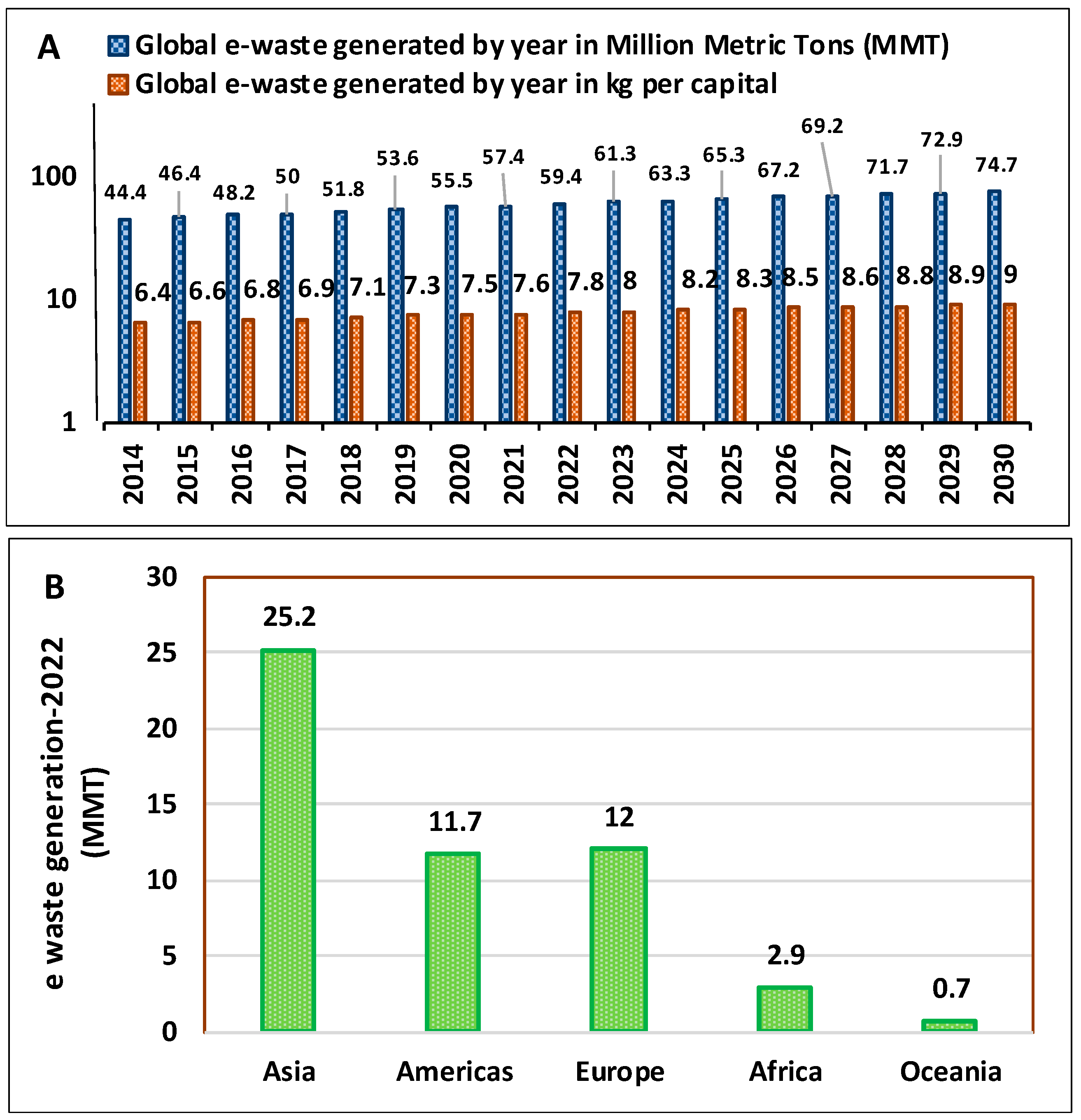
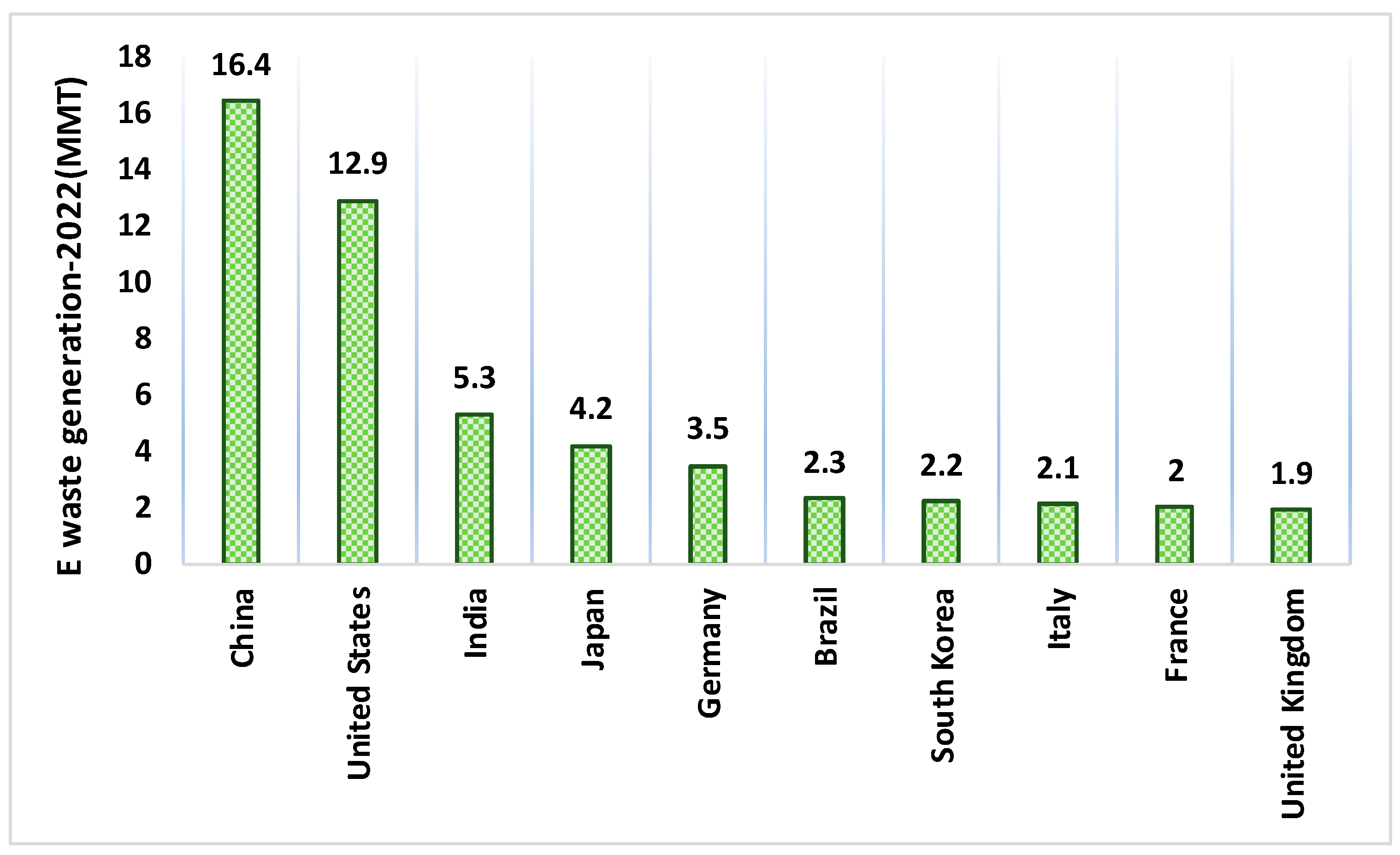

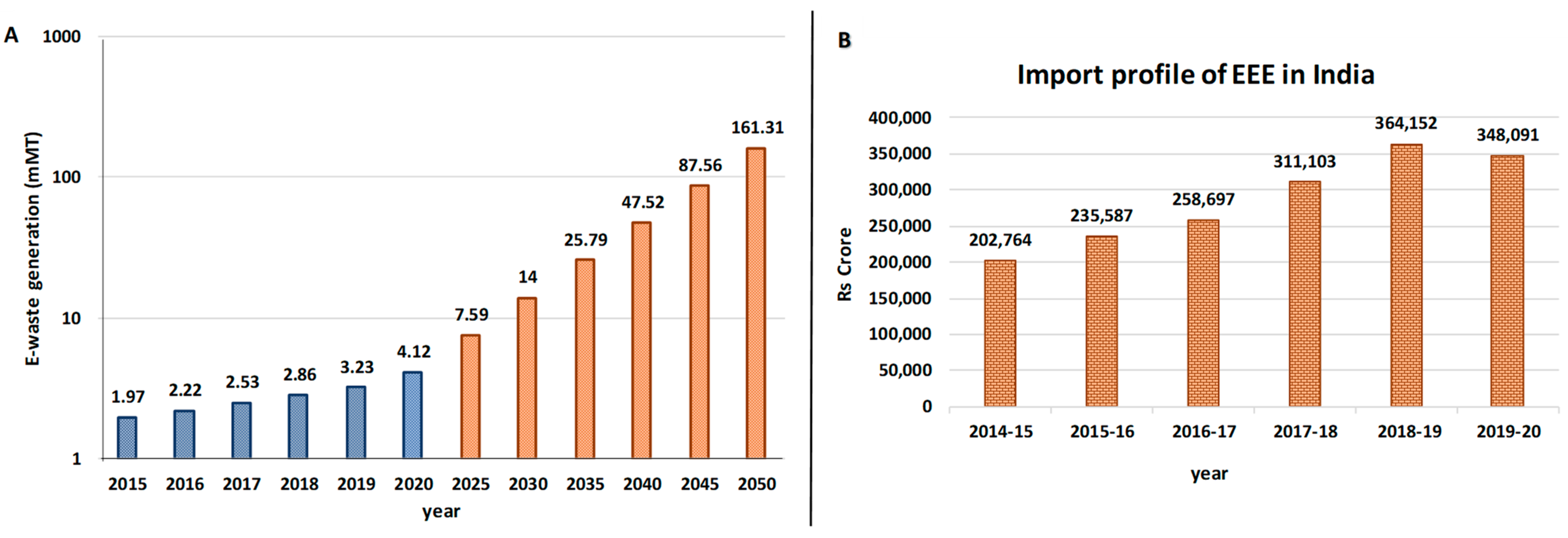


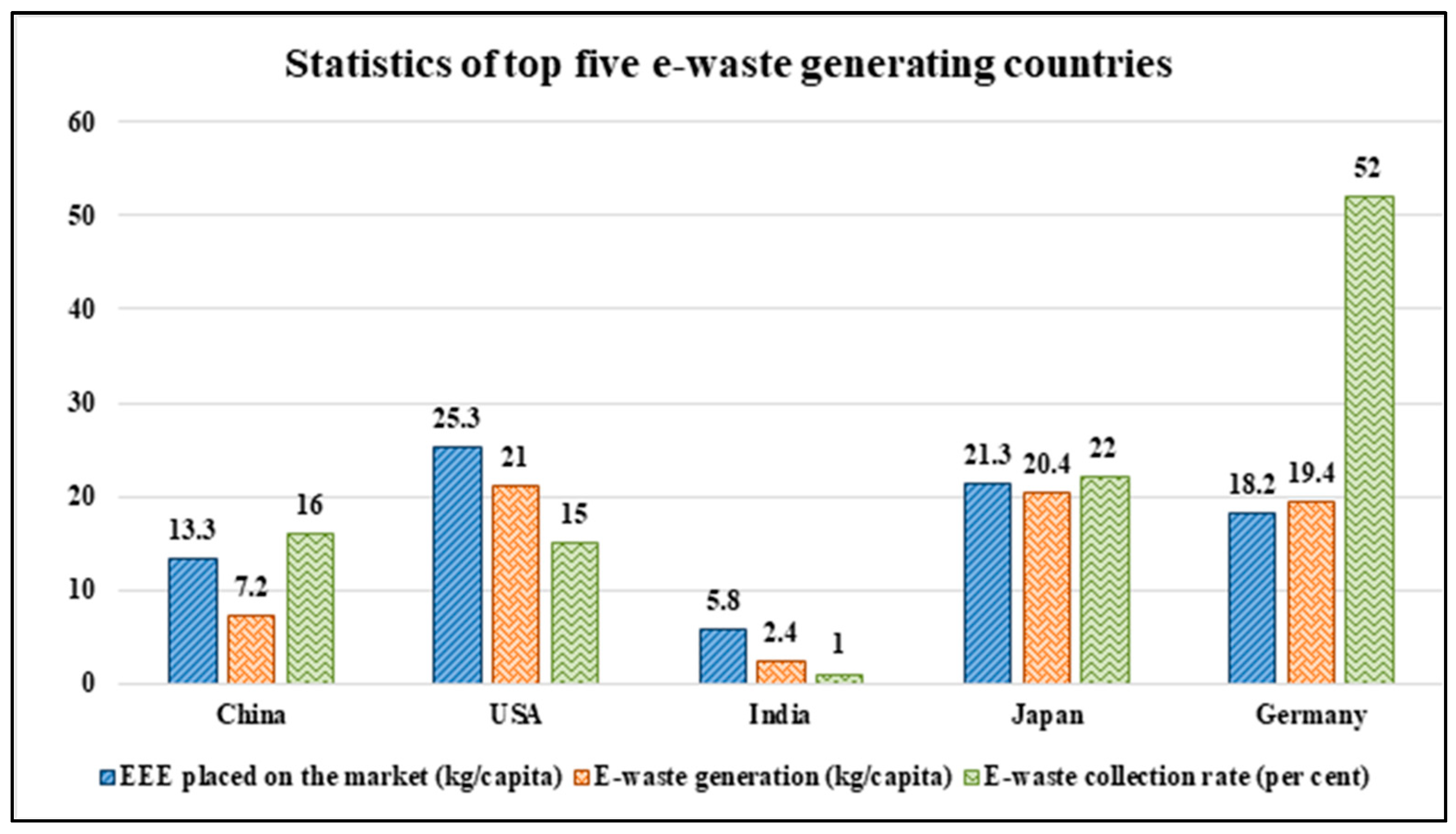
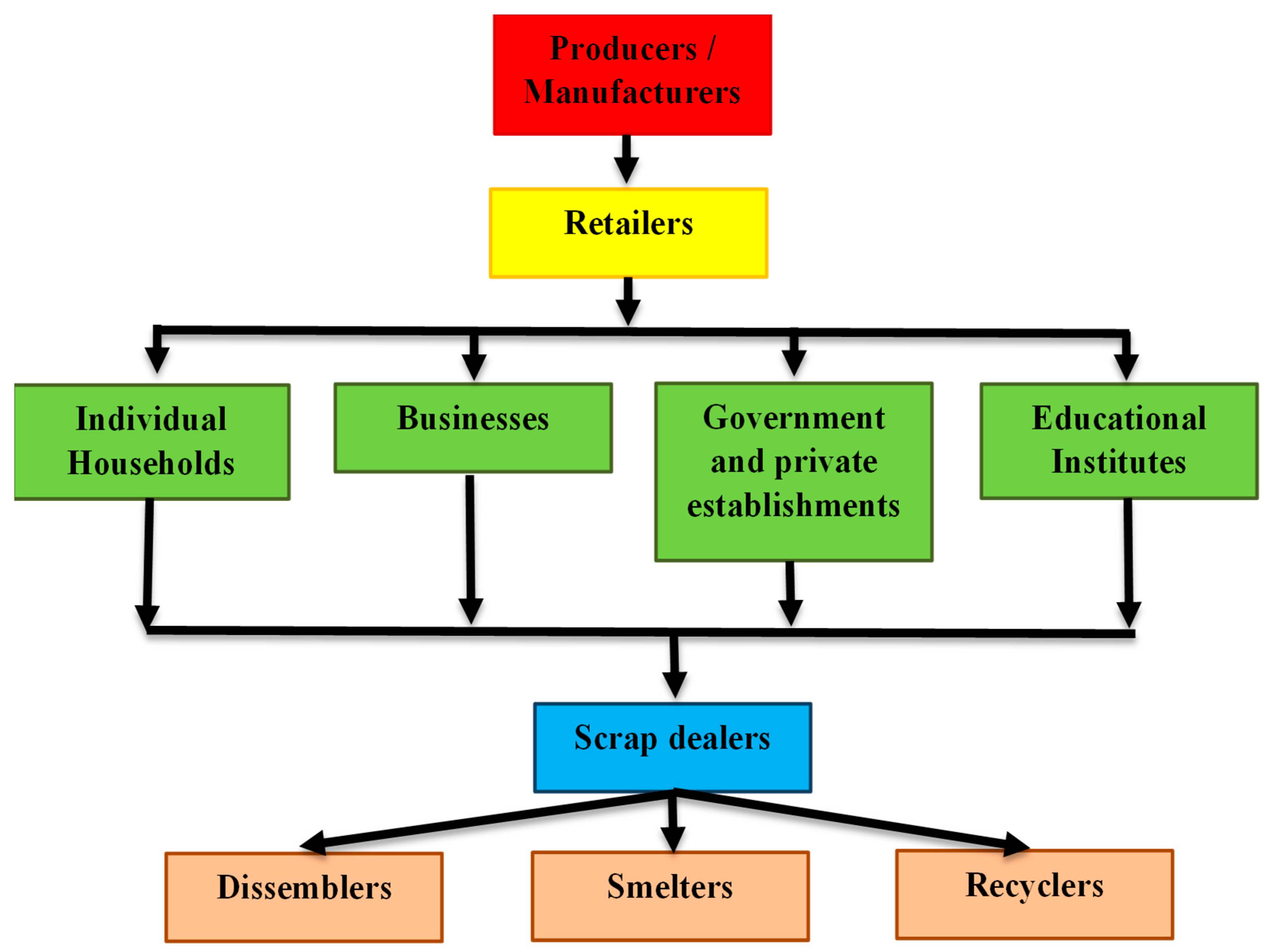
| Study Title | Field of Use | Reference | Highlights |
|---|---|---|---|
| A novel hydrometallurgical-pyrometallurgical method for efficient recovery of valuable metals from electronic waste | Material Recycling | [18] | Introduces a novel method combining hydrometallurgical and pyrometallurgical approaches for efficient recovery of valuable metals from e-waste. |
| Rare earth elements in electronic waste: A global perspective and outlook | Electronics Manufacturing | [21] | Provides a comprehensive analysis of global rare earth elements in e-waste, discussing their distribution and recycling potential. |
| Life cycle assessment of e-waste reuse and recycling: A global analysis | Sustainability Assessment | [19] | Offers a comprehensive life cycle assessment comparing environmental impacts of e-waste reuse and recycling strategies. |
| E-waste art: Creative approaches for environmental sustainability | Art and Design | [20] | Explores creative use of e-waste in art, highlighting its potential for promoting environmental awareness through artistic expressions. |
| E-waste as a potential resource for electricity generation | Energy Generation | [22] | Investigates the feasibility of using e-waste as a fuel source for generating electricity. |
| A circular economy approach to e-waste management: A review | Material Recycling | [24] | Advocates for a circular economy approach in e-waste management, emphasising resource recovery and waste minimisation. |
| E-waste management in developing countries: Challenges and opportunities | Socioeconomic Impact | [25] | Analyses challenges and opportunities of e-waste management in developing nations, stressing the need for improved infrastructure and regulations. |
| Environmental impact of e-waste reuse and recycling | Sustainability Assessment | [26] | Conducts a global life cycle assessment comparing environmental impacts of e-waste reuse and recycling. |
| Health risks associated with exposure to toxic components in electronic waste | Environmental Health Assessment | [17] | Reviews health risks from exposure to toxic components in e-waste, advocating stricter regulations and awareness initiatives. |
| E-waste as a potential energy resource | Energy Generation | [23] | Assesses global potential of e-waste as an energy source for electricity generation. |
Disclaimer/Publisher’s Note: The statements, opinions and data contained in all publications are solely those of the individual author(s) and contributor(s) and not of MDPI and/or the editor(s). MDPI and/or the editor(s) disclaim responsibility for any injury to people or property resulting from any ideas, methods, instructions or products referred to in the content. |
© 2023 by the authors. Licensee MDPI, Basel, Switzerland. This article is an open access article distributed under the terms and conditions of the Creative Commons Attribution (CC BY) license (https://creativecommons.org/licenses/by/4.0/).
Share and Cite
Nandan, A.; Suresh, A.C.; Saole, P.; Jeevanasai, S.A.; Chandrasekaran, R.; Meili, L.; Wan Azelee, N.I.; Selvasembian, R. An Integrated Approach for Electronic Waste Management—Overview of Sources of Generation, Toxicological Effects, Assessment, Governance, and Mitigation Approaches. Sustainability 2023, 15, 16946. https://doi.org/10.3390/su152416946
Nandan A, Suresh AC, Saole P, Jeevanasai SA, Chandrasekaran R, Meili L, Wan Azelee NI, Selvasembian R. An Integrated Approach for Electronic Waste Management—Overview of Sources of Generation, Toxicological Effects, Assessment, Governance, and Mitigation Approaches. Sustainability. 2023; 15(24):16946. https://doi.org/10.3390/su152416946
Chicago/Turabian StyleNandan, Abhishek, Albin C. Suresh, Parth Saole, S. Amulya Jeevanasai, Ramprasad Chandrasekaran, Lucas Meili, Nur Izyan Wan Azelee, and Rangabhashiyam Selvasembian. 2023. "An Integrated Approach for Electronic Waste Management—Overview of Sources of Generation, Toxicological Effects, Assessment, Governance, and Mitigation Approaches" Sustainability 15, no. 24: 16946. https://doi.org/10.3390/su152416946
APA StyleNandan, A., Suresh, A. C., Saole, P., Jeevanasai, S. A., Chandrasekaran, R., Meili, L., Wan Azelee, N. I., & Selvasembian, R. (2023). An Integrated Approach for Electronic Waste Management—Overview of Sources of Generation, Toxicological Effects, Assessment, Governance, and Mitigation Approaches. Sustainability, 15(24), 16946. https://doi.org/10.3390/su152416946










